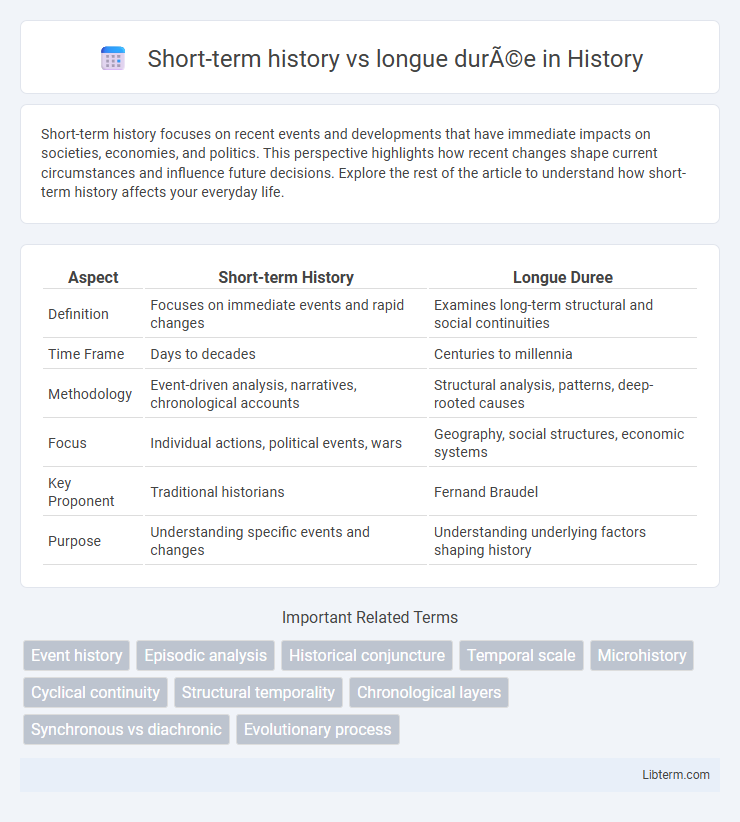Short-term history focuses on recent events and developments that have immediate impacts on societies, economies, and politics. This perspective highlights how recent changes shape current circumstances and influence future decisions. Explore the rest of the article to understand how short-term history affects your everyday life.
Table of Comparison
| Aspect | Short-term History | Longue Duree |
|---|---|---|
| Definition | Focuses on immediate events and rapid changes | Examines long-term structural and social continuities |
| Time Frame | Days to decades | Centuries to millennia |
| Methodology | Event-driven analysis, narratives, chronological accounts | Structural analysis, patterns, deep-rooted causes |
| Focus | Individual actions, political events, wars | Geography, social structures, economic systems |
| Key Proponent | Traditional historians | Fernand Braudel |
| Purpose | Understanding specific events and changes | Understanding underlying factors shaping history |
Defining Short-term History and Longue Durée
Short-term history emphasizes specific events, actions, and decisions occurring over brief periods, often focusing on political and military developments. Longue duree prioritizes long-term structures, social patterns, and environmental factors that influence historical change across centuries. This approach enables historians to understand deep-rooted trends beyond immediate occurrences.
The Origins of the Longue Durée Approach
The origins of the longue duree approach trace back to historian Fernand Braudel, who emphasized analyzing historical phenomena over extended time frames to capture enduring structures and patterns beyond immediate events. This methodology contrasts sharply with traditional short-term history that focuses on discrete episodes, political events, or individual actions. By prioritizing geographical, social, and economic contexts spanning centuries, the longue duree approach reveals deep-rooted causes shaping historical change.
Key Proponents of Each Perspective
Fernand Braudel is a key proponent of longue duree, emphasizing deep structures and long-term historical trends that shape societies beyond immediate events. In contrast, historians like E.H. Carr prioritize short-term history, focusing on specific events, decisions, and individuals that directly influence historical outcomes. The debate between these perspectives centers on whether history is best understood through broad, slow-changing forces or detailed, event-driven analysis.
Analytical Methods in Short-term Analysis
Short-term history emphasizes detailed examination of specific events over days, months, or years, using methods such as archival research, oral histories, and event-focused quantitative analysis to uncover immediate causes and effects. Analytical methods in short-term analysis prioritize chronological sequencing, identifying pivotal moments, and assessing direct impacts on societies or individuals, often employing tools like primary source comparison and microhistorical approaches. This contrasts with longue duree's focus on long-term structural patterns, as short-term history provides granular insights into historical dynamics within a constrained temporal frame.
Structural Patterns in the Longue Durée
Structural patterns in the longue duree emphasize enduring social, economic, and cultural frameworks that shape historical developments over centuries, contrasting sharply with short-term events and individual actions. This approach highlights persistent factors such as geography, climate, population dynamics, and institutional structures that influence civilizations beyond immediate crises or political changes. Historians like Fernand Braudel advocate for analyzing these deep-rooted patterns to understand the broader context and slow evolution of societies.
Benefits of Focusing on Immediate Events
Focusing on immediate events in short-term history allows for a detailed understanding of specific occurrences, providing precise insights into cause-and-effect relationships. This approach enables historians to capture the nuances of critical moments, such as political revolutions or economic crises, facilitating targeted analysis. Concentrating on short-term events enhances the ability to respond to contemporary challenges by drawing lessons from recent experiences.
The Significance of Deep Historical Structures
Deep historical structures reveal long-term social, economic, and cultural patterns that shape contemporary events beyond immediate occurrences. The longue duree approach emphasizes persistent factors such as geography, institutions, and demographic trends, providing a comprehensive framework for understanding historical continuity. Short-term history, by contrast, concentrates on specific events and moments, often overlooking these foundational influences crucial for interpreting broader historical developments.
Challenges in Balancing Both Approaches
Balancing short-term history and longue duree poses challenges due to their differing temporal perspectives and methodological demands. Short-term history emphasizes immediate events and detailed narratives, while longue duree analyzes long-term structural changes and social dynamics across centuries. Integrating these approaches requires reconciling granular, event-specific data with broad, systemic patterns to achieve a comprehensive understanding of historical processes.
Case Studies: Short-term vs Longue Durée in Practice
Case studies illustrate the contrast between short-term history, which emphasizes specific events and immediate causes, and longue duree, focusing on long-term structural and cultural factors shaping societies. Short-term analysis highlights pivotal moments like revolutions or battles, while longue duree examines enduring patterns such as economic systems or social hierarchies over centuries. Combining both approaches provides a comprehensive understanding of historical phenomena by linking immediate actions to broader, persistent trends.
Toward an Integrated Historical Understanding
Short-term history emphasizes specific events and rapid changes, while longue duree explores enduring structures and slow social evolutions over centuries. Combining these perspectives allows historians to integrate immediate occurrences with broader societal patterns for a comprehensive understanding of historical phenomena. This integrated approach enriches analysis by revealing how short-term events both influence and are shaped by long-term processes.
Short-term history Infographic

 libterm.com
libterm.com